When we think of birdsong, the enchanting melodies of songbirds often come to mind. However, the world of bird vocalizations extends beyond the traditional notion of singing. Among the avian wonders, hummingbirds stand out with their vibrant colours and mesmerizing flight.
But do hummingbirds sing? In this guide, we will explore the vocal abilities of hummingbirds and delve into the fascinating sounds they produce.
From their distinctive chirps and buzzing wings to unique courtship displays, we will unravel the mystery of hummingbird vocalizations and uncover the secrets behind their unique auditory expressions.
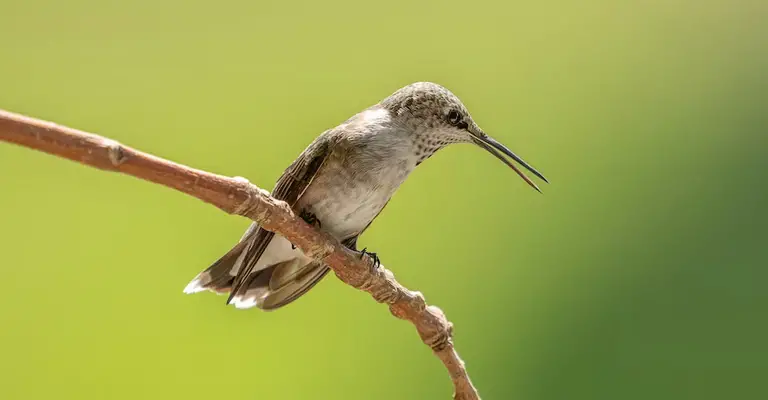
Do Hummingbirds Sing?
Hummingbirds are not known for their singing abilities in the traditional sense. While they may not produce melodic songs like some other bird species, hummingbirds do have vocalizations that they use for communication and territorial displays.
These vocalizations are usually short, rapid chirps, trills, or buzzing sounds.
Male hummingbirds, in particular, are known for their unique vocalizations during courtship displays.
They produce distinct sounds that are part of their elaborate mating rituals. These vocalizations, often described as “songs” or “calls,” are produced by rapid wingbeats and air passing through specialized feathers.
These vocalizations serve various purposes, including attracting mates, defending territories, communicating with other hummingbirds, and displaying dominance.
While not as complex as the songs of other bird species, the vocalizations of hummingbirds are an important part of their communication repertoire and play a role in their social interactions.
What Is The Sound Of A Hummingbird Called?
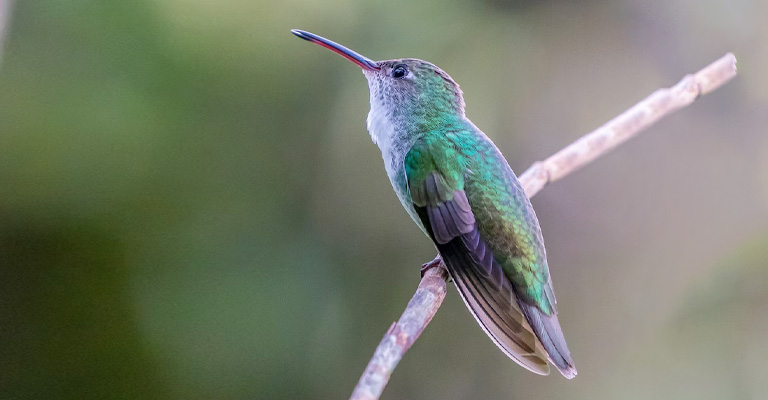
The sounds produced by hummingbirds are referred to as vocalizations or calls. These vocalizations can vary in their nature and purpose, serving as important forms of communication among these tiny birds.
Here are some key types of hummingbird vocalizations:
Chirping
Hummingbirds often produce short, rapid chirping sounds. These chirps can serve as general communication signals between individuals or as territorial displays during confrontations with other hummingbirds.
The chirps are typically high-pitched and can vary in intensity and frequency.
Trilling
Hummingbirds may also produce trilling sounds, which are rapid and continuous sequences of short notes. Trilling vocalizations often occur during courtship displays, where males showcase their abilities to potential mates.
These trills are complex and can be quite melodious.
Buzzing
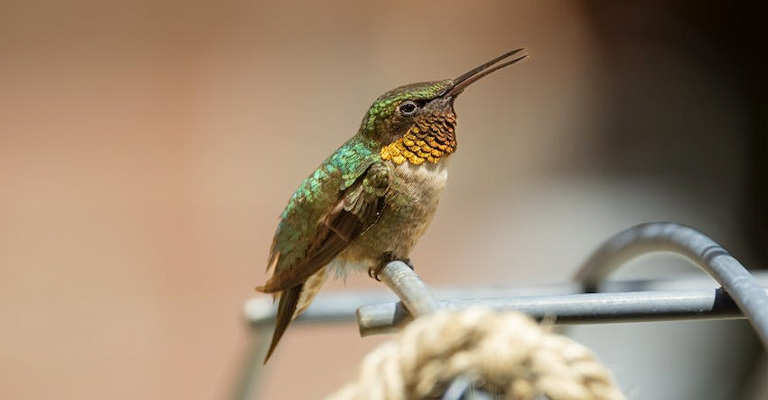
Another distinctive vocalization of hummingbirds is buzzing. This sound is produced by the rapid movement of their wings during flight. As the wings beat at high frequencies, they create a humming or buzzing noise, giving the birds their name.
The buzzing sound can vary in intensity and pitch depending on the species and wingbeat speed.
Whistling
Some hummingbirds are known to produce whistling sounds, particularly during territorial disputes or courtship displays. These whistles are often sharp and piercing, serving as clear signals to communicate dominance or to attract mates.
Clicking
Hummingbirds may also produce clicking sounds, usually associated with aggressive behaviours or during courtship rituals. These clicks are short and sharp, often occurring in quick succession.
While the vocalizations of hummingbirds may not be as complex or melodic as the songs of other bird species, they are an integral part of their communication repertoire.
These sounds play a crucial role in establishing territories, attracting mates, defending resources, and maintaining social interactions among these remarkable avian creatures.
What Do Hummingbirds Sound Like?
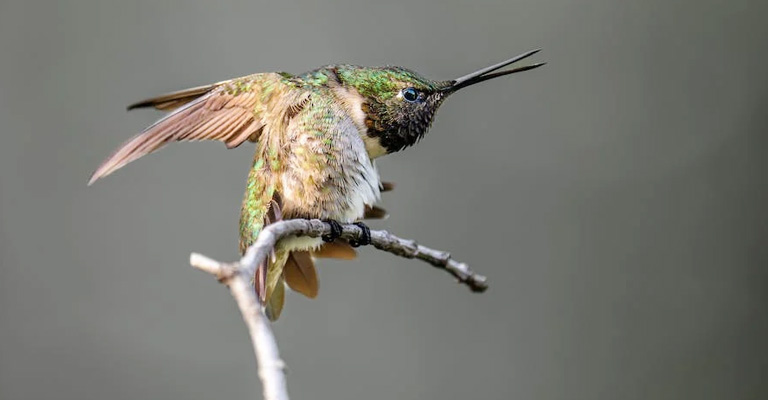
Hummingbirds produce a variety of sounds that contribute to their auditory presence in their environments. Here are some descriptions of what hummingbirds sound like:
Chirping Sounds
Hummingbirds often emit short, rapid chirping sounds. These chirps can vary in pitch and intensity. The chirping is typically high-pitched and can be heard during various activities, such as feeding, perching, or engaging in territorial disputes.
The chirping sounds serve as communication signals between individuals and can indicate alertness or aggression.
Buzzing or Humming
The buzzing or humming sound is synonymous with hummingbirds and is named after them. This distinct sound is generated by the rapid beating of their wings during flight.
As their wings move at remarkable speeds, they create a continuous buzzing or humming noise. The pitch and intensity of the buzzing can vary depending on the species and wingbeat frequency, ranging from a low hum to a high-pitched buzz.
Trilling
During courtship displays, male hummingbirds may produce trilling sounds. These trills are rapid, continuous sequences of short notes, creating a melodious and vibrating sound.
The trilling can be quite complex and is often accompanied by aerial displays, adding an enchanting element to their courtship rituals.
Whistling or Piping
Hummingbirds can produce whistling or piping sounds, particularly during territorial disputes or courtship displays. These sounds are often sharp and piercing, resembling short whistles or high-pitched piping notes.
The whistling or piping serves as clear signals of aggression, dominance, or attraction between hummingbirds.
Wing and Tail Sounds
Hummingbirds’ wing and tail feathers can create additional sounds during their flight and manoeuvres. The rapid wingbeats generate a distinct whirring or fluttering noise, while the movement of their tail feathers can produce swooshing or rustling sounds.
These sounds accompany their agile flight patterns and add to the overall sensory experience of observing hummingbirds.
Overall, the sounds of hummingbirds encompass a range of chirps, buzzing, trilling, whistling, and the accompanying wing and tail sounds.
These auditory elements enhance the captivating presence of these small avian wonders and contribute to the delight of witnessing their acrobatic displays and vibrant behaviours.
Which Hummingbirds Are the Best Singers?
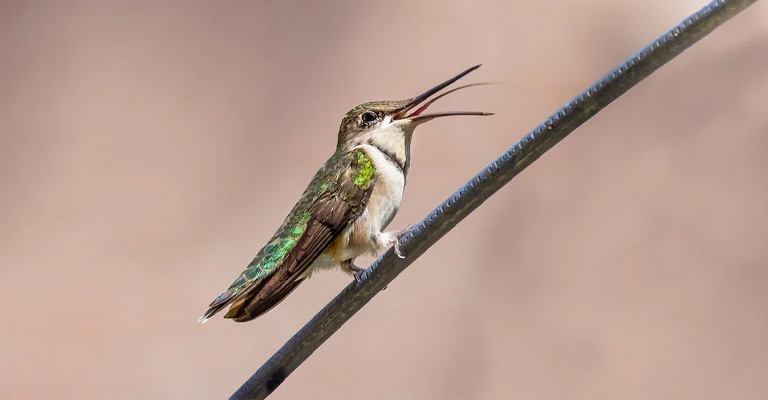
Hummingbirds are not particularly known for their singing abilities compared to other bird species. However, some hummingbird species are known to produce more complex and melodious vocalizations than others.
Here are a few hummingbird species that are considered notable singers:
Anna’s Hummingbird (Calypte anna):
Anna’s Hummingbird is known for its distinctive song, which consists of a series of scratchy and buzzy notes. Males perform intricate vocalizations during courtship displays, creating a captivating and unique sound that adds to their courtship rituals.
Calliope Hummingbird (Selasphorus calliope):
The Calliope Hummingbird is the smallest breeding bird in North America, but it possesses a surprisingly loud and melodious song. Males produce a high-pitched, tinkling song during courtship, resembling the sound of tiny bells or chimes.
Costa’s Hummingbird (Calypte costae):
Costa’s Hummingbird is known for its enchanting vocalizations during courtship displays. Males emit a distinct, high-pitched, and repetitive song consisting of buzzy and whistling notes.
Their songs often accompany their breathtaking aerial displays.
Rufous Hummingbird (Selasphorus rufus):
Male Rufous Hummingbirds produce a complex and melodious song during courtship. Their vocalizations include a series of high-pitched, warbling notes that are delivered in rapid sequences, creating a beautiful and captivating sound.
Violet-crowned Hummingbird (Amazilia violaceus): The Violet-crowned Hummingbird is known for its sweet, musical, and flute-like song. Males produce a melodic series of whistling notes during courtship displays, creating an enchanting atmosphere in their native habitats.
While these hummingbird species are considered notable for their vocalizations, it’s important to note that hummingbirds’ songs are generally less complex and melodic compared to other bird species known for their elaborate songs.
Nonetheless, the unique vocalizations of these hummingbirds add to the overall charm and fascination of observing these tiny avian wonders.
What Does It Mean When Hummingbirds Chirp at You?
When hummingbirds chirp at you, their behaviour can have different interpretations depending on the context and circumstances. Here are some possible meanings behind hummingbirds chirping at you:
Curiosity
Hummingbirds are naturally curious creatures, and if they chirp at you, it may indicate their interest in your presence. They may be trying to assess whether you pose a threat or have something of interest to offer, such as a food source or flowers.
Warning or Alarm
Chirping can also serve as a warning or alarm call. If a hummingbird perceives you as a potential threat or if you approach too closely to their nest or territory, they may chirp to alert you or other hummingbirds to their presence and potential danger.
Communication
Hummingbirds use vocalizations, including chirping, as a means of communication with each other and other creatures in their environment. When they chirp at you, they may be conveying information or attempting to establish communication, such as asserting their territory or expressing their presence.
Vocal Displays
Chirping can be part of a vocal display during courtship or territorial disputes. Male hummingbirds may chirp to attract mates or to assert dominance over rivals. If you observe this behaviour, it may indicate that you are witnessing a display of courtship or territorial behaviour.
Vocalizing in Response
Hummingbirds are known to respond vocally to external stimuli, including human presence. If you make sudden movements or produce sounds that catch their attention, they may chirp in response as part of their natural reaction to the stimulus.
It is important to note that while hummingbirds may chirp at you, their behaviour is generally not aggressive or meant to cause harm. They are small and delicate birds, and their vocalizations are more likely expressions of their natural instincts and communication rather than direct threats.
Enjoy the experience of interacting with these fascinating creatures and appreciate the unique communication they share through their chirping.
FAQ
Hummingbirds do produce vocalizations, but their sounds are distinct from the melodious songs of many other bird species. Their vocalizations include chirps, trills, and buzzing sounds, which serve various communication purposes.
Hummingbirds are more renowned for their incredible flight abilities and vibrant colours than for their singing. Their vocalizations are typically shorter, less complex, and less melodic compared to the elaborate songs of songbirds.
Hummingbird vocalizations serve multiple purposes, including communication between individuals, defending territories, attracting mates during courtship displays, and warning of potential threats.
Hummingbird vocalizations can be high-pitched and rapid, making them sometimes difficult for humans to hear without aid. However, with attentive listening or the use of audio recording devices, their vocalizations can be appreciated and studied.
While there are commonalities in hummingbird vocalizations, each species can have its own unique vocal repertoire. The specific sounds and patterns of vocalizations can vary between hummingbird species and even within populations.
Conclusion
While hummingbirds may not possess the melodious songs of songbirds, they certainly possess a range of vocal abilities that set them apart.
Through their chirps, buzzes, trills, and vocal displays, hummingbirds communicate, defend territories, attract mates, and assert their presence in their unique ways.
Their soundscape is a symphony of rapid wingbeats, chirping calls, and intricate courtship rituals. While hummingbirds may not sing in the conventional sense, their vocalizations showcase their adaptability, resilience, and remarkable ability to communicate and thrive in their diverse habitats.
So, the next time you encounter a hummingbird, listen closely to the subtle sounds it produces and marvel at the symphony of nature in which these tiny avian wonders play their part.
